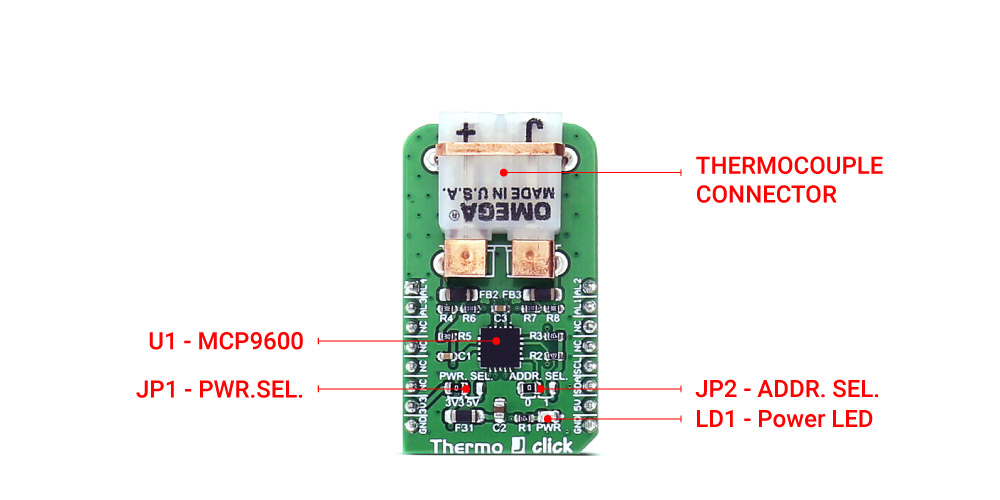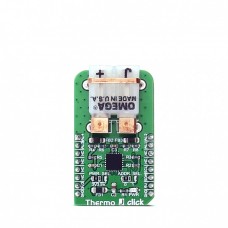Thermo J click
Thermo J click is a temperature measurement click board™, which uses a thermocouple type-J probe, connected to a PPC-SMP-J onboard connector. The active part of the Thermo J click is MCP9600 by Microchip - a thermocouple EMF to temperature converter, with 1.5°C of maximum accuracy. The onboard PCC-SMP-J connector ensures the secure connection and accurate readings for the connected thermocouple.
The main advantage of the thermocouples over some other types of temperature measuring devices is a wide range of temperatures that they can measure. With the addition of four programmable ALERT lines routed to the mikroBUS™ pins, Thermo J click is an ideal solution for the temperature measurements in extreme conditions, hard to reach places, machinery, and similar applications.
How does the click work?
Thermo J click utilizes the thermoelectric principles for measuring the temperature. When the thermocouple joint, made of two different conductive materials, is exposed to a measuring temperature (hot end), a potential difference will be generated at the open ends of the circuit (cold end). The generated electromotive force (EMF) at the open ends of the circuit can be measured and converted into a digital form, by the 18-bit delta-sigma AD converter section of the MCP9600 IC.
To obtain the desired measurement of the temperature, the cold end temperature needs to be known, too. Since the MCP9600 features an integrated measurement of the ambient temperature (cold junction compensation), error corrected value can be read directly from the registers, using the I2C bus protocol.
The generated EMF depends on the materials that are used for the thermocouples.Those materials are standardized and categorized by types. This click uses the type-J thermocouples, composed of iron and constantan. The measuring range of this device for the type J probes, is from -150°C to 1200°C, but it depends on the used probes. Thermo J click uses a specially constructed PPC-SMP-J onboard connector for easy and secure thermocouple connection.
There are four ALERT lines present on the MCP9600. Those lines can be programmed by the I2C to be set to a HIGH logic level when certain temperature thresholds are reached. The lines are routed to the AN, RST, PWM and INT pins of the mikroBUS™.
The I2C address can be selected with the ADDR SEL onboard SMD jumper. The I2C address can be changed by this jumper, allowing for more than one of these click boards to be used on a system, each with the different I2C address.
The click board™ can be set to work with both 3.3V or 5V, selectable from the mikroBUS™. This can be done by the onboard SMD jumper, labeled as PWR SEL. This allows for this click board™ to be used on a wide range of different MCUs, both 3.3V and 5V tolerant.
Note: Thermo J click needs Thermocouple Type-J probes which are sold separately.
Specifications
| Type | Temperature |
| Applications | Ideal solution for the temperature measurements in extreme conditions, hard to reach places, machinery, and similar applications. |
| Key Features | Measuring wide range of temperatures, ranging from -150°C to 1200°C - depending on the used probes, comes with the PCC-SMP-Type-J connector for the secure connecting of the thermocouple probes, integrated cold junction compensation. |
| Interface | GPIO,I2C |
| Input Voltage | 3.3V or 5V |
| Click board size | M (42.9 x 25.4 mm) |
Pinout diagram
This table shows how the pinout on Thermo J click corresponds to the pinout on the mikroBUS™ socket (the latter shown in the two middle columns).
Thermo J click electrical specifications
| Description | Min | Typ | Max | Unit |
|---|---|---|---|---|
| I/O pins voltage ratings | 2.7 | 5.5 | V | |
| I2C clock frequency | 10 | 100 | kHz | |
| Measuring range for the Type J probes | -150 | 1200 | °C |
Onboard settings and indicators
| Label | Name | Default | Description |
|---|---|---|---|
| JP1 | PWR SEL | Left | Power supply voltage selection. Left position 3.3V, right position 5V |
| JP2 | ADDR SEL | Left | I2C address selection. Left position is 1100000x, right position is 1100111x. |
| PWR | Power LED | - | Power LED indicates that the click is powered on |
Software support
We provide a library for the Thermo J click on our LibStock page, as well as a demo application (example), developed using MikroElektronika compilers. The demo can run on all the main MikroElektronika development boards.
Library Description
The library contains functions which are used to communicate and control the Thermo J click. Temperature read and write functions require the I2C slave address as an argument - so that more than one device with the different slave addresses can be used on the same I2C bus.
Key functions
float THERMOJ_getTemperature(uint8_t slaveAddress) - Returns current temperature in Celsius
void THERMOJ_write_byte(uint8_t slaveAddress, uint8_t registerAddress, uint8_t value) - Writes single byte to any register
uint8_t THERMOJ_read_byte(uint8_t slaveAddress, uint8_t registerAddress)- Reads single byte from any register
Examples Description
The application is composed of three sections:
- System Initialization - Initializes pins, I2C peripheral, UART used for logging
- Application Initialization -Initializes driver and configures module
- Application Task - (code snippet) Sequential temperature measurement every 500 milliseconds. Measurement readings will be logged to UART
void applicationTask()
{
temperature = THERMOJ_getTemperature(_THERMOJ_ADDRESS_GND);
FloatToStr(temperature,text);
LOG_write("Current temperature: ", _LOG_TEXT);
LOG_write(text, _LOG_LINE);
Delay_ms(500);
}
Other MikroElektronika libraries used in the example:
- UART
- Conversions
Additional notes and information
Depending on the development board you are using, you may need USB UART click, USB UART 2 click or RS232 click to connect your PC for development systems with no UART to USB interface available on the board. The terminal available in all MikroElektronika compilers, or any other terminal application of your choice can be used to read the message.
Downloads
mikroBUS™ Standard specificationsThermo J click schematic
MCP9600 datasheet
Enter the code in the box below:



